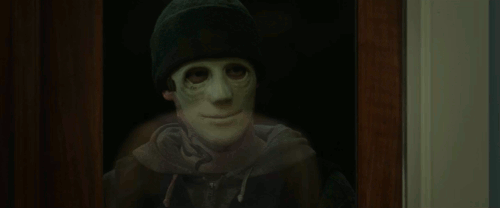It's Just Another Scary Movie... Isn't It?
Every year, thousands of people flock to theaters and pay to sit in a dark, undecorated room where they willingly subject themselves to a visual and aural display that leaves them with elevated heart rates, sweaty palms, and a petrifying fear of what’s lurking in the shadows.
While books provide the words and imagery for you to create the story in your mind, films incorporate elements of storytelling that books can’t.
They include moving visuals, musical scores, sound effects, costumes and props. When we look at what these techniques and effects can add to our viewing of the horror genre and, more importantly, to the presentation of isolation, viewers are given an entirely different experience.
Now we can physically see how isolated a character may be, whether that isolation is because they’re staying in a remote cabin or if it’s because they’re alienated from their peers. Our own perception of the character’s isolation can also be influenced by the sound of a lone violin or, perhaps, by the complete absence of sound. Horror movies simply provide audiences with different, and perhaps more intimate, interactions with isolation.
You may be wondering how I was able to file through nearly 120 years of horror films and narrow it down to only three. Well, it certainly wasn’t easy. When I began this project, I had originally selected 13 films:
-
Night of the Living Dead (1968)
-
Alien (1979)
-
Friday the 13th (1980)
-
Friday the 13th Part 2 (1981)
-
Friday the 13th Part III (1982)
-
Friday the 13th: The Final Chapter (1984)
-
Scream (1996)
-
Scream 2 (1997)
-
Scream 3 (2000)
-
The Conjuring (2013)
-
Hush (2016)
-
Annabelle: Creation (2017)
-
The Nun (2018)
I had selected these movies because of how they embodied different forms of isolation, and felt they also covered the spectrum of the genre by representing several different subgenres and tropes: zombies, aliens, supernatural and mortal psychopaths, hauntings, and demons.
But analyzing over 22 hours of film seemed too daunting of a task given the time I had. Not to mention the fact that watching that many horror films in such a short amount of time would have seriously affected my sleep schedule and peace of mind.
I love horror movies, but I’m also a giant chicken.
That being said, I decided to narrow my selection down to three films: Alien (1979), Scream (1996), and Hush (2016). These movies incorporate several different elements of isolation, some of which can be found in the novels Dracula and Frankenstein.
This will allow us not only to look at how these films have expanded upon the isolation themes that were present in the novels, but to also look at isolation in ways that the novels didn’t, or couldn’t, have explored.
Why Alien?
Set in the desolate expanse of space, with sudden and gruesome deaths and an alien who only appears on screen for 4 minutes, who wouldn’t have chosen Alien? Ridley Scott’s cinematic masterpiece changed the face of the horror genre by introducing the fascinating subgenre, science fiction horror.
Scott utilized silence and darkness in ways that hadn’t yet been attempted in the film industry. Rather than accompanying every scene with a musical score, the hour and fifty-seven minute film only has thirty-three minutes of dissonant background music. The rest of the film’s silence is filled with the sounds of the setting, such as dripping water, blowing steam, or footsteps on a metal boardwalk.
The star of Alien, the 7.5ft xenomorph that haunts the air ducts and dark corners of the ship, is also only seen for a grand total of four minutes throughout the entirety of the original film. This limited interaction and exposure to the chestbursting menace leads to the characters, as well as the audience, fearing every inch of the ship, as we never know where the alien is hiding. These filming techniques revolutionized the filming of horror movies and provide us with several different depictions of isolation and its role in the film.
Why Scream?
With the 9th film in the Friday the 13th franchise released in 1993 and the 7th Nightmare on Elm Street in 1994, the horror film industry saw a steady decline in interest due to the repetitive and uncreative continuations of once popular films. Scream was like a breath of fresh air for the horror genre, as it introduced a new feature to the genre while still incorporating the tropes fans loved.
Most horror movies follow the typical and reoccuring themes of the genre, they rarely mention or acknowledge them, except for the occasional character who is aware of their limited chance of survival. Scream broke this trend by being the first horror film that was self-aware of itself, as well as of the genres’ tropes and themes. It simultaneously offered the comfort of familiar and consistent tropes, which are crucial in an otherwise ever evolving genre, while also making fun of them and horror movies as a whole.
In short, Scream is hilarious, as the film is comically self-aware, and heart-stopping, due to the complicated characters and misleading plot.
Why Hush?
With Alien being released in ‘79 and Scream in ‘96, I felt that I needed a more recent film to help bring a fresh and new perspective into my project. As a result, Hush was selected. It was released in 2016 and, so far, has yet to be discussed within the horror field. With less than 15 minutes of dialogue throughout the entire film, it offers an entirely new kind of isolation, and is one of my most favorite new age horror films.
With a main character who is deaf-mute and lives alone in the woods, this film offers a perspective on isolation that no other horror film had yet to attempt. While the plot is canonically typical for a horror movie, a girl living alone in the woods must outwit a sadistic psychopath dead set on killing her, the inclusion of said girl having to survive while lacking two of the most important senses in a situation such as this gives an anxiety-inducing and intriguing new spin to an old trope.
This, combined with the fact that the lead character is arguably one of the most well-written female protagonists to grace the horror genre, made Hush a must for my project.
WARNING: SPOILERS AHEAD!
Obviously, in a project that intends to analyze films, there will be spoilers. So if you haven’t seen any of these films, and you care about having the plots spoiled, then I suggest you take a moment and watch them.
It’s only 309 minutes collectively to watch all three.
Totally do-able.
( But seriously? Come on. You’ve had plenty of time to watch these movies.
Like, 40 years in Alien’s case. Get with the times, man.)










